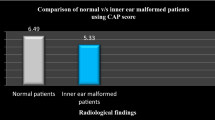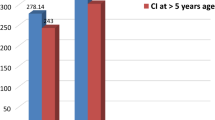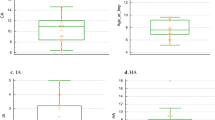Abstract
Cochlear implantation (CI) is used for rehabilitation of children with bilateral severe to profound sensorineural hearing loss. Recently, treatment of such children has been influenced by diagnostic technological advances. Infants and toddlers are now increasingly included for CI. The primary aim of this study was to determine the effects of ‘age at CI’ on CI outcome. The primary aim of this study was to determine the effects of ‘age at CI’ on CI outcome. In this prospective study at a tertiary care centre, we evaluated 50 cochlear implanted children from October 2011 to March 2013. The case group consists of 15 (30%) children who underwent CI at more than 5 years of age and control group consisted of 35 (70%) children who underwent CI at less than or equal to 5 years age. All patients received auditory and speech rehabilitation and we evaluated their auditory perception outcomes 1 year post CI, the children were assessed by categories of auditory performance (CAP) and meaningful auditory integration scale (MAIS) tests. There were significantly improved mean auditory perception outcomes (increase of 12.29% in CAP, and 14.05% in MAIS scores) at 1 year post CI in CI recipients of age group ‘5 years or less’ in comparison to those who underwent CI at ‘more than 5 years of age’. However, children of ‘more than 5 years’ age at CI, mean CAP and MAIS scores were still more than 80% of maximum achievable CAP and MAIS scores. In this study, CI recipient children who were implanted at less than or equal to 5 years of age were found to have significantly improved auditory perception outcome at 1 year post CI. Hence, it appears preferable to provide CI early. However, even in children who underwent CI at more than 5 years of age, there was substantial improvement in auditory perception outcomes and CI was still helpful in these children. Hence, knowledge of ‘age at CI’ can provide reasonable help in predicting the auditory perception outcome and optimal counselling of families of CI candidates.

Similar content being viewed by others
References
Miyamoto RT, Osberger MJ, Todd SL, Robbins AM, Stroer BS, Zimmerman-Phillips SZ et al (1994) Variables affecting implant performance in children. Laryngoscope 104:1120–1124
Dowell RC, Cowan RSC (1997) Evaluation of benefit: infants and children. In: Clark GM (ed) CI for infants and Children—advances. Singular Publishing Group, San Diego, pp 205–222
Osberger M (1998) Speech recognition performance of older children with cochlear implants. Am J Otol 19:152–157
Tye-Murray N, Spencer L, Woodworth GG (1995) Acquisition of speech by children who have prolonged cochlear implant experience. J Speech Hear Res 38:327–337
Archbold S, Lutman ME, Marshal DH (1995) Category of auditory performance. Ann Otol Rhinol Laryngol 166(Suppl. 1):312–314
Zimmerman-Phillips S, Robbins AM, Osberger MJ (2001) Infant–toddler meaningful auditory integration score. Calif. Advanced Bionics Corp, Sylmar
Blamey P, Arndt P, Bergeron F (1996) Factors affecting auditory performance of postlingually deaf adults using cochlear implants. Audiol Neurootol 1:293–306
Holt RF, Svirsky MA (2008) An exploratory look at pediatric cochlear implantation: is earliest always best? Ear Hear 29(4):492–511
Waltzman SB, Roland JT Jr. (2005) Cochlear implantation in children younger than 12 months. Pediatrics 116(4):e487–e493
Roland JT Jr., Cosetti M, Wang KH et al (2009) Cochlear implantation in the very young child: long-term safety and efficacy. Laryngoscope 119(11):2205–2210
Colletti V, Carner M, Miorelli V et al (2005) Cochlear implantation at under 12 months: report on 10 patients. Laryngoscope 115(3):445–449
Niparko JK, Tobey EA, Thal DJ et al (2010) Spoken language development in children following cochlear implantation. JAMA 303(15):1498–1506
Connor CM, Craig HK, Raudenbush SW et al (2006) The age at which young deaf children receive cochlear implants and their vocabulary and speech-production growth: is there an added value for early implantation? Ear Hear 27(6):628–644
Miyamoto RT, Hay-McCutcheon MJ, Kirk KI et al (2008) Language skills of profoundly deaf children who received cochlear implants under 12 months of age: a preliminary study. Acta Otolaryngol 128(4):373–377
Tajudeen BA, Waltzman SB, Jethanamest D et al (2010) Speech perception in congenitally deaf children receiving cochlear implants in the first year of life. Otol Neurotol 31(8):1254–1260
Hammes DM, Novak MA, Rotz LA et al (2002) Early identification and cochlear implantation: critical factors for spoken language development. Ann Otol Rhinol Laryngol Suppl 189:74–78
Arisi E, Forti S, Pagani D et al (2010) Cochlear implantation in adolescents with prelinguistic deafness. Otolaryngol Head Neck Surg 142(6):804–808
Waltzman S, Roland JT, Cohen N (2002) Delayed implantation in congenitally deaf children and adults. Otol Neurotol. 23:333–340
Sarant J, Blamey PJ, Dowell RC, Gibson WPR (2001) Variation in auditory perception scores amongst children with cochlear implant. Ear Hear 22(1):18–28
Fisher RA (1950) Statistical methods for research workers. Oliver and Boyd, London
Government of India. Ministry of social justice and empowerment (2015). Corrigendum—guidelines approved for hearing impaired for financial assistance under revised ADIP scheme-modifications regarding [Report No. 4-2 (8)/2014/DD-I]. Department of Empowerment of Persons with Disabilities, New Delhi
Government of India. Ministry of health and family welfare (2009). Office memorandum—reimbursement of the cost of cochlear implant to beneficiaries under CGHS/Central Services (Medical Attendance) Rules, 1944 (File No. 6-469/2003-CGHS/R&H). Department of Health and Family Welfare, New Delhi
Funding
Nil.
Author information
Authors and Affiliations
Contributions
Dr. Vishal Gaurav: Concept and design of study, acquisition of data/analysis and interpretation of data. Dr. Shalabh Sharma: Manuscript review and final approval of the version to be published. Dr. Satinder Singh: Manuscript review.
Corresponding author
Ethics declarations
Conflict of interest
All authors declare that they have no conflict of interest.
Additional information
Publisher's Note
Springer Nature remains neutral with regard to jurisdictional claims in published maps and institutional affiliations.
Rights and permissions
About this article
Cite this article
Gaurav, V., Sharma, S. & Singh, S. Effects of Age at Cochlear Implantation on Auditory Outcomes in Cochlear Implant Recipient Children. Indian J Otolaryngol Head Neck Surg 72, 79–85 (2020). https://doi.org/10.1007/s12070-019-01753-4
Received:
Accepted:
Published:
Issue Date:
DOI: https://doi.org/10.1007/s12070-019-01753-4




